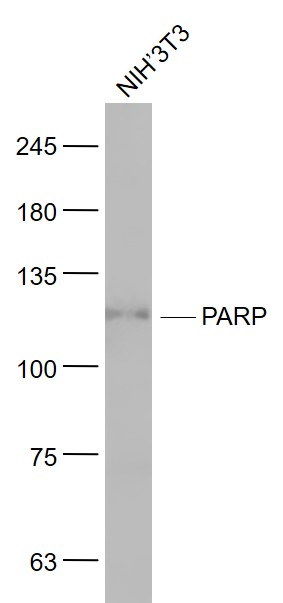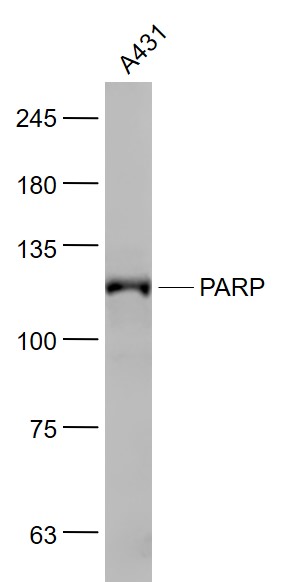
Mouse Anti-PARP1 antibody
ADP ribosyltransferase (NAD+; poly (ADP ribose) polymerase); ADP ribosyltransferase NAD+; ADPRT 1; ADPRT; ADPRT1; msPARP; NAD(+) ADP ribosyltransferase 1; pADPRT 1; pADPRT1; PARP 1; PARP; Poly (ADP ribose) polymerase 1; poly (ADP ribose) polymerase family
View History [Clear]
Details
Product Name PARP1 Chinese Name 多腺苷二磷酸多聚酶/多聚ADP-核糖聚合酶1单克隆抗体 Alias ADP ribosyltransferase (NAD+; poly (ADP ribose) polymerase); ADP ribosyltransferase NAD+; ADPRT 1; ADPRT; ADPRT1; msPARP; NAD(+) ADP ribosyltransferase 1; pADPRT 1; pADPRT1; PARP 1; PARP; Poly (ADP ribose) polymerase 1; poly (ADP ribose) polymerase family, member 1; Poly adenosine diphosphate ADP ribose polymerase; Poly ADP ribose polymerase 1; Poly ADP ribose polymerase family member 1; Poly ADP ribose synthetase 1; poly(ADP ribose) synthetase; poly(ADP ribosyl)transferase; Poly[ADP ribose] synthetase 1; PPOL; sPARP 1; sPARP1; PARP1_HUMAN. literatures Research Area Tumour Cardiovascular Cell biology Signal transduction Apoptosis The new supersedes the old Mitochondrion Immunogen Species Mouse Clonality Monoclonal Clone NO. 5B7 React Species Human, Mouse, Applications WB=1:500-1000 ELISA=1:5000-10000
not yet tested in other applications.
optimal dilutions/concentrations should be determined by the end user.Theoretical molecular weight 116kDa Cellular localization The nucleus cytoplasmic The cell membrane Mitochondrion Form Liquid Concentration 1mg/ml immunogen KLH conjugated synthetic peptide derived from human PARP1 Lsotype IgG Purification affinity purified by Protein G Buffer Solution 0.01M TBS(pH7.4) with 1% BSA, 0.03% Proclin300 and 50% Glycerol. Storage Shipped at 4℃. Store at -20 °C for one year. Avoid repeated freeze/thaw cycles. Attention This product as supplied is intended for research use only, not for use in human, therapeutic or diagnostic applications. PubMed PubMed Product Detail This gene encodes a chromatin-associated enzyme, poly(ADP-ribosyl)transferase, which modifies various nuclear proteins by poly(ADP-ribosyl)ation. The modification is dependent on DNA and is involved in the regulation of various important cellular processes such as differentiation, proliferation, and tumor transformation and also in the regulation of the molecular events involved in the recovery of cell from DNA damage. In addition, this enzyme may be the site of mutation in Fanconi anemia, and may participate in the pathophysiology of type I diabetes. [provided by RefSeq, Jul 2008].
Function:
Involved in the base excision repair (BER) pathway, by catalyzing the poly(ADP-ribosyl)ation of a limited number of acceptor proteins involved in chromatin architecture and in DNA metabolism. This modification follows DNA damages and appears as an obligatory step in a detection/signaling pathway leading to the reparation of DNA strand breaks. Mediates the poly(ADP-ribosyl)ation of APLF and CHFR. Positively regulates the transcription of MTUS1 and negatively regulates the transcription of MTUS2/TIP150. With EEF1A1 and TXK, forms a complex that acts as a T-helper 1 (Th1) cell-specific transcription factor and binds the promoter of IFN-gamma to directly regulate its transcription, and is thus involved importantly in Th1 cytokine production.
Subunit:
Component of a base excision repair (BER) complex, containing at least XRCC1, PARP2, POLB and LRIG3. Homo- and heterodimer with PARP2. Interacts with PARP3, APTX and SRY. The SWAP complex consists of NPM1, NCL, PARP1 and SWAP70. Interacts with TIAM2 and ZNF423 (By similarity). Interacts (when poly-ADP-ribosylated) with CHD1L. Interacts with the DNA polymerase alpha catalytic subunit POLA1; this interaction functions as part of the control of replication fork progression. Interacts with EEF1A1, RNF4 and TXK.
Subcellular Location:
Mitochondrion outer membrane; Single-pass membrane protein.
Nucleus membrane; Single-pass membrane protein.
Endoplasmic reticulum membrane; Single-pass membrane protein.
Nucleus.
Post-translational modifications:
Phosphorylated by PRKDC and TXK. Phosphorylated upon DNA damage, probably by ATM or ATR.
Poly-ADP-ribosylated by PARP2. Poly-ADP-ribosylation mediates the recruitment of CHD1L to DNA damage sites.
S-nitrosylated, leading to inhibit transcription regulation activity.
Similarity:
Contains 1 BRCT domain.
Contains 1 PARP alpha-helical domain.
Contains 1 PARP catalytic domain.
Contains 2 PARP-type zinc fingers.
SWISS:
P09874
Gene ID:
142
Database links:Entrez Gene: 142 Human
Entrez Gene: 11545 Mouse
Omim: 173870 Human
SwissProt: P09874 Human
SwissProt: P11103 Mouse
Unigene: 177766 Human
Unigene: 277779 Mouse
Unigene: 11327 Rat
Product Picture
NIH/3T3(Mouse) Cell Lysate at 30 ug
Primary: Anti- PARP (SLM-33137M) at 1/1000 dilution
Secondary: IRDye800CW Goat Anti-Mouse IgG at 1/20000 dilution
Predicted band size: 116 kD
Observed band size: 116 kD
References (0)
No References
Bought notes(bought amounts latest0)
No one bought this product
User Comment(Total0User Comment Num)
- No comment




 +86 571 56623320
+86 571 56623320
 +86 18668110335
+86 18668110335

